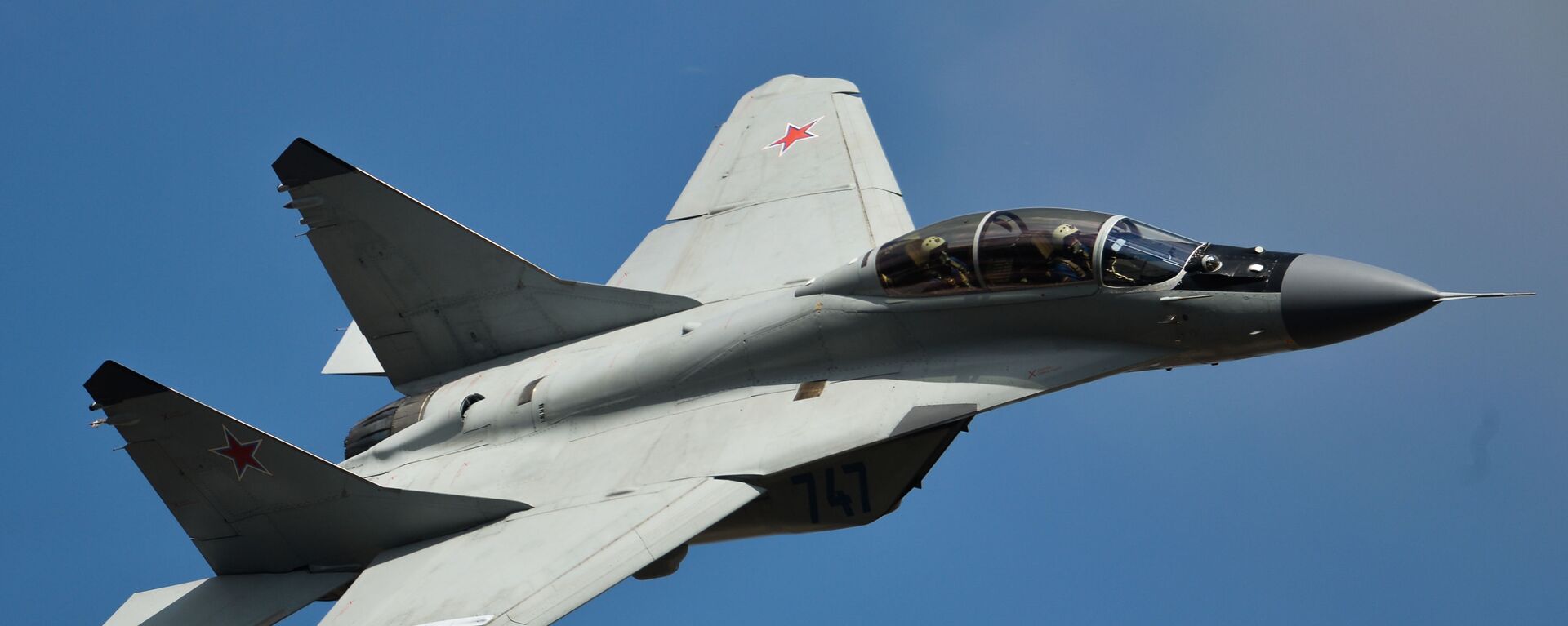https://sputnikglobe.com/20230822/what-is-the-fastest-fighter-jet-in-the-world-today-1112789685.html
What is the Fastest Fighter Jet in the World Today
What is the Fastest Fighter Jet in the World Today
Sputnik International
MiG-25 Foxbat, a Soviet supersonic interceptor, is regarded as both the fastest fighter aircraft in the world to enter service and the only aircraft capable of achieving speeds over Mach 3.0 that is currently in use by air forces.
2023-08-22T19:30+0000
2023-08-22T19:30+0000
2023-08-22T23:33+0000
sputnik explains
ussr
mig
fighter aircraft
world record
speed
https://cdn1.img.sputnikglobe.com/img/107796/10/1077961056_0:108:3259:1941_1920x0_80_0_0_d8976b1b44d9cee360073fdfd11fd57e.jpg
Speed gives a fighter aircraft a distinct advantage in battle, allowing it to either chase down or outrun enemy planes, though a plane must be sturdy enough to endure the strain caused by acceleration, not to mention that the aircraft’s design must account for the g-force the pilot has to deal with.Throughout the era of aviation, many fighter aircraft claimed the title of the fastest, only to be surpassed by their more recent and more advanced counterparts.So which fighter aircraft today can be described as the fastest of its kind in the world? Sputnik explains.Fastest Fighter Aircraft in the WorldDespite the fact that it is the United States who long enjoyed the reputation of the country with probably the most powerful and advanced military air force in history, the fastest fighter aircraft in the world to enter service is the MiG-25, a supersonic interceptor designed in the Soviet Union during the 1960s.Originally designated as project E-155, the prototype aircraft that would become the MiG-25 performed its first test flight in 1964. The state testing of the new warplane continued from 1965 through 1970, with Soviet engineers taking their time due to the uniqueness of the aircraft’s design.Some of the test flights were conducted over the Sinai Peninsula, Egyptian territory that was occupied by Israeli forces at the time. The Soviet aircraft conducted reconnaissance flights over the area while Israeli planes and ground-based air defense systems simply could not keep up with it.In 1972, the MiG-25 was formally adopted by the Air Defense Forces of the Soviet Union as a weapon that would allow the USSR to counter the US supersonic bomber and reconnaissance aircraft.Designated “Foxbat” by the NATO alliance, the MiG-25 became the first Soviet interceptor capable of reaching Mach 2.83 speed (about 3,000 kilometers per hour). While the MiG-25 got enough thrust to reach Mach 3.2 speed, pilots were advised not to exceed the Mach 2.83 speed limit in order to avoid engine overheating.In August 1977, Soviet test pilot Alexander Fedotov flying a MiG-25 set the altitude world record for air breathing jet aircraft (37,650 meters) that has not been beaten to this day.Various modifications of MiG-25 were exported by USSR to other countries and participated in conflicts the Soviet Union was not involved in. For example, in 1991 an Iraqi MiG-25 shot down a US F/A-18 Hornet fighter aircraft, thus causing the only officially recognized US air-to-air combat loss during the Gulf War.While some nations still field MiG-25 fighter jets, the warplane has since been retired by the majority of states that used it, including Russia.The MiG-25 is also regarded as the only aircraft capable of achieving speeds over Mach 3.0 that is currently in use by air forces.What Aircraft Are Faster Than MiG-25While the MiG-25 still counts as the fastest mass-produced fighter aircraft in the world, it is by no means the fastest aircraft overall.For example, the US SR-71 Blackbird reconnaissance aircraft, designed and built by Lockheed and adopted by the US in the 1960s, could attain Mach 3.4 speed. In fact, it was the existence of such fast spy planes in the US arsenal that prompted the development of MiG-25s by the USSR in the first place.SR-71, however, was not a fighter aircraft, though it is currently regarded as probably the fastest manned jet aircraft in the world.The YF-12 interceptor aircraft, similarly designed by Lockheed, also deserves a mention. This aircraft, whose first flight took place in 1963, could also surpass the Mach 3 speed and, unlike Blackbird, could carry several air-to-air missiles.Alas, YF-12 never advanced past the prototype stage, with only three such aircraft being built before the US Air Force lost interest in the project.While the US military apparently had no use for YF-12, the aircraft was used by NASA for research purposes.XB-70 Valkyrie was a prototype supersonic strategic bomber developed by the North American Aviation in the 1950s.The Valkyrie, a prototype for the planned B-70 bomber, was capable of climbing above 20,000 meters where it could cruise at a speed of Mach 3 and (slightly) above, which was supposed to make this aircraft untouchable to enemy interceptors.Valkyrie’s downfall came with the realization by the US military officials that the aircraft was not impervious to the surface-to-air missiles employed by the USSR.While the bomber’s development was cancelled, the few Valkyries that were produced were used for research purposes until these aircraft were finally retired by the end of the 1960s.And then there is X-15, a US rocket-powered aircraft designed by North American Aviation, whose first flight took place way back in 1959. This experimental aircraft, made for research and testing purposes, was able to fly at Mach 6.7 speed, thus setting the world record for highest speed recorded by manned powered aircraft.Only three X-15 were built before the aircraft’s retirement during the late 1960s. That said, X-15 was not a jet aircraft, as is apparent from the “rocket-powered” bit in its description, nor was it a fighter aircraft.
https://sputnikglobe.com/20230812/mig-35-vs-f-16-russian-veteran-pilot-explains-which-plane-would-win-in-a-dogfight-1112552714.html
https://sputnikglobe.com/20230809/su-57-edges-out-f-35-to-emerge-sentinel-of-skies-1112468913.html
ussr
Sputnik International
feedback@sputniknews.com
+74956456601
MIA „Rosiya Segodnya“
2023
News
en_EN
Sputnik International
feedback@sputniknews.com
+74956456601
MIA „Rosiya Segodnya“
Sputnik International
feedback@sputniknews.com
+74956456601
MIA „Rosiya Segodnya“
fastest fighter jet in the world mach, fastest fighter jet in the world 2023, mig-25 foxbat, how fast is mig-25
fastest fighter jet in the world mach, fastest fighter jet in the world 2023, mig-25 foxbat, how fast is mig-25
What is the Fastest Fighter Jet in the World Today
19:30 GMT 22.08.2023 (Updated: 23:33 GMT 22.08.2023) Ever since the first aircraft took flight in the beginning of the 20th century, aeronautical engineers all over the globe have been striving to build a plane that would fly the fastest, with their efforts becoming even more urgent when it became apparent that aircraft can be used in warfare.
Speed gives a fighter aircraft a distinct advantage in battle, allowing it to either chase down or outrun enemy planes, though a plane must be sturdy enough to endure the strain caused by acceleration, not to mention that the aircraft’s design must account for the g-force the pilot has to deal with.
Throughout the era of aviation, many fighter aircraft claimed the title of the fastest, only to be surpassed by their more recent and more advanced counterparts.
So which fighter aircraft today can be described as the fastest of its kind in the world? Sputnik explains.
Fastest Fighter Aircraft in the World
Despite the fact that it is the United States who long enjoyed the reputation of the country with probably the most powerful and advanced military air force in history, the fastest fighter aircraft in the world to enter service is the MiG-25, a supersonic interceptor designed in the Soviet Union during the 1960s.
Originally designated as project E-155, the prototype aircraft that would become the MiG-25 performed its first test flight in 1964. The state testing of the new warplane continued from 1965 through 1970, with Soviet engineers taking their time due to the uniqueness of the aircraft’s design.
Some of the test flights were conducted over the Sinai Peninsula, Egyptian territory that was occupied by Israeli forces at the time. The Soviet aircraft conducted reconnaissance flights over the area while Israeli planes and ground-based
air defense systems simply could not keep up with it.

12 August 2023, 10:53 GMT
In 1972, the MiG-25 was formally adopted by the Air Defense Forces of the Soviet Union as a weapon that would allow the USSR to counter the US supersonic bomber and reconnaissance aircraft.
Designated “Foxbat” by the NATO alliance, the MiG-25 became the first Soviet interceptor capable of reaching Mach 2.83 speed (about 3,000 kilometers per hour). While the MiG-25 got enough thrust to reach Mach 3.2 speed, pilots were advised not to exceed the Mach 2.83 speed limit in order to avoid engine overheating.
In August 1977, Soviet test pilot Alexander Fedotov flying a MiG-25 set the altitude world record for air breathing jet aircraft (37,650 meters) that has not been beaten to this day.
Various modifications of MiG-25 were exported by USSR to other countries and participated in conflicts the Soviet Union was not involved in. For example, in 1991 an Iraqi MiG-25 shot down a US F/A-18 Hornet fighter aircraft, thus causing the only officially recognized US air-to-air combat loss during the
Gulf War.
While some nations still field MiG-25 fighter jets, the warplane has since been retired by the majority of states that used it, including Russia.
The MiG-25 is also regarded as the only aircraft capable of achieving speeds over Mach 3.0 that is currently in use by air forces.
What Aircraft Are Faster Than MiG-25
While the MiG-25 still counts as the fastest mass-produced fighter aircraft in the world, it is by no means the fastest aircraft overall.
For example, the US SR-71 Blackbird reconnaissance aircraft, designed and built by Lockheed and adopted by the US in the 1960s, could attain Mach 3.4 speed. In fact, it was the existence of such fast spy planes in the US arsenal that prompted the development of MiG-25s by the USSR in the first place.
SR-71, however, was not a fighter aircraft, though it is currently regarded as probably the fastest manned jet aircraft in the world.
The YF-12 interceptor aircraft, similarly designed by Lockheed, also deserves a mention. This aircraft, whose first flight took place in 1963, could also surpass the Mach 3 speed and, unlike Blackbird, could carry several air-to-air missiles.
Alas, YF-12 never advanced past the prototype stage, with only three such aircraft being built before the US Air Force lost interest in the project.
While the US military apparently had no use for YF-12, the aircraft was used by NASA for research purposes.
XB-70 Valkyrie was a prototype supersonic strategic bomber developed by the North American Aviation in the 1950s.
The Valkyrie, a prototype for the planned B-70 bomber, was capable of climbing above 20,000 meters where it could cruise at a speed of Mach 3 and (slightly) above, which was supposed to make this aircraft untouchable to enemy interceptors.
Valkyrie’s downfall came with the realization by the US military officials that the aircraft was not impervious to the surface-to-air missiles employed by the USSR.
While the bomber’s development was cancelled, the few Valkyries that were produced were used for research purposes until these aircraft were finally retired by the end of the 1960s.
And then there is X-15, a US rocket-powered aircraft designed by North American Aviation, whose first flight took place way back in 1959. This experimental aircraft, made for research and testing purposes, was able to fly at Mach 6.7 speed, thus setting the world record for highest speed recorded by manned powered aircraft.
Only three X-15 were built before the aircraft’s retirement during the late 1960s. That said, X-15 was not a jet aircraft, as is apparent from the “rocket-powered” bit in its description, nor was it a
fighter aircraft.





